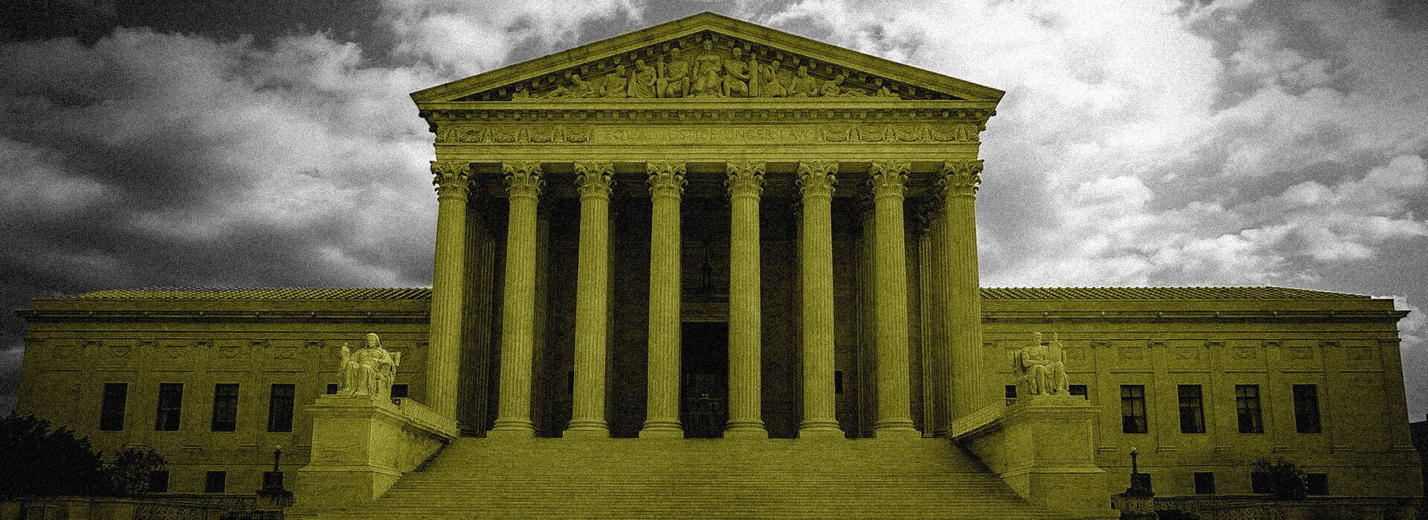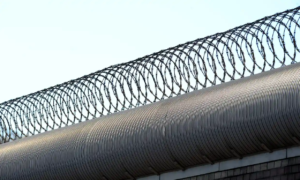At 1:23 a.m. on Saturday, the Trump administration finished its 13th and final execution. Dustin Higgs, a Black man who had been scheduled to die on Martin Luther King Jr.’s birthday, was put to death while suffering from COVID-19.
Like those who had been executed before him, there were extensive unresolved legal problems with Higgs’ case. But like the previous executions, on the day the federal government wanted Higgs to die, the Supreme Court quickly dispensed with those issues and allowed the killing to proceed, only a few hours behind schedule. The justices didn’t explain why. There was no apparent reason, other than submitting to then-President Donald Trump’s desire to execute as many people as possible before leaving office.
It was an extraordinary and irreversible miscarriage of justice that capped a historically unprecedented six-month killing spree. From the Trump administration’s first executions in July 2020 to the final ones last week, the Supreme Court sided with the government every time, repeatedly allowing the rushed killings of people with outstanding legal claims. Some of those who faced the death penalty had future hearings scheduled before lower courts, wiped away by the Supreme Court so their execution could proceed on schedule before Trump left office.
“This unprecedented rush of federal executions has predictably given rise to many difficult legal disputes,” Justice Sonia Sotomayor wrote in a fiery dissent last Friday night in Higgs’ case. “Against this backdrop of deep legal uncertainty, the [Department of Justice] did not tread carefully,” Sotomayor continued, detailing the government’s efforts to fast-track the killings “before courts had meaningful opportunities to determine if the executions were legal.”
At a time when the Supreme Court should have served as a check on the executive branch’s zealous pursuit of capital punishment, it instead rubber-stamped the killings, lending a false sense of legitimacy to the process. “Throughout this expedited spree of executions, this Court has consistently rejected inmates’ credible claims for relief. The Court has even intervened to lift stays of execution that lower courts put in place, thereby ensuring those prisoners’ challenges would never receive a meaningful airing,” Sotomayor wrote.
The Supreme Court often made these life-or-death decisions in a matter of hours, with no public explanation of the court’s reasoning. “This is not justice,” Sotomayor wrote. “After waiting almost two decades to resume federal executions, the Government should have proceeded with some measure of restraint to ensure it did so lawfully. When it did not, this Court should have. It has not.”
One-third of the justices on the high court were nominated to their lifetime posts by a president who was elected by a minority of voters and who was impeached twice, most recently for inciting a violent riot against the U.S. Capitol to protest his reelection loss. The views of those justices may have sealed the fate of many of the 13 people put to death since July — and could impact other people on federal death row for decades to come.
The issues the Supreme Court sidestepped in allowing executions to proceed are fundamental to the legality of the death penalty as practiced. There is ongoing litigation about the federal government’s current method of execution, a lethal overdose of pentobarbital. Autopsies show that the process often causes pulmonary edema, a medical condition that induces the sensation of drowning or suffocating. The federal district court in Washington, D.C., has issued multiple preliminary injunctions, including one stating that death row prisoners had demonstrated they were likely to succeed in proving the execution protocol violates the Eighth Amendment’s prohibition on cruel and unusual punishment. But each time the issue made it to the Supreme Court, the justices allowed the executions to proceed.
“A layperson might say, ‘If you don’t know whether it’s legal, can you go ahead and do it?’ And most people would say, ‘Of course not,’” Robert Dunham, the executive director of the Death Penalty Information Center, said in an interview. “But that’s not the path the Supreme Court has taken.”
Wesley Purkey and Lisa Montgomery were killed despite credible evidence that neither of them was mentally competent to be executed. Brandon Bernard was killed without getting the chance to present evidence that the government had secured his death sentence by withholding exculpatory information. Alfred Bourgeois and Corey Johnson were killed despite credible evidence that they had intellectual disabilities that made them ineligible for the death penalty. Johnson and Higgs were killed even though there was credible medical evidence that lung damage from their bouts with COVID-19 could make their executions torturously and unconstitutionally painful.
– Robert Dunham, executive director of the Death Penalty Information Center
Perhaps the Supreme Court’s most stunning disregard for due process came on Jan. 15, the Friday night Higgs was scheduled to be executed. Federal law requires executions to be conducted in the manner authorized by the state where the conviction occurred. Higgs was convicted in Maryland, which has since abolished the death penalty. The government had asked a federal district court to allow him to be executed in the manner authorized in Indiana, where Higgs was imprisoned on federal death row. The district court denied the government’s request and the government appealed to the U.S. Court of Appeals for the 4th Circuit. The appellate court set oral arguments for Jan. 27, one week into the administration of President Joe Biden, who is expected to halt federal executions.
Intent on killing Higgs before leaving office, the Trump administration asked the Supreme Court to intervene. Late Friday night, the high court acquiesced to the government’s request and allowed Higgs’ execution to go forward. Higgs was pronounced dead a little more than two hours later.
It was an unprecedented move, according to legal experts. “The Court didn’t just lift a lower stay, but issued a summary ruling on the merits of the case even though the court of appeals hadn’t yet done so,” Steve Vladeck, a professor at the University of Texas School of Law, explained on Twitter. “And all to expedite an execution.”
The move was consistent with the Supreme Court’s refusal to address issues raised in the previous execution cases. “Every contested motion that was filed in the U.S. Supreme Court was decided in favor of execution over the course of 13 cases. The only way that these case outcomes can be reconciled with the rule of law is if you think the rule of law means, ‘If the federal government wants a prisoner dead, the prisoner is dead.’ That’s the only way that you can reconcile what the courts did,” Dunham said.
“It looked like rubber-stamping. It looked like result-orientation,” Dunham continued. “They knew the outcome before the papers ever came to them.”
The Supreme Court’s refusal to delay executions became so clear to those on death row that some stopped looking to it for relief. Before he was killed, Christopher Vialva told anti-death penalty lawyer Ashley Kincaid Eve that he didn’t want her to file a last-minute challenge to his execution, The Intercept reported. Vialva knew that Daniel Lewis Lee, the first person to be executed by the Trump administration, waited on the gurney for four hours while his lawyers fought, unsuccessfully, to save his life. That wasn’t how Vialva wanted to spend his final hours.
– Supreme Court Justice Sonia Sotomayor
The lower courts were complicit, too. In November, two men incarcerated at the federal prison in Terre Haute, Indiana — where death row is located — filed a class-action lawsuit to stop the executions until the coronavirus pandemic had ended or until the prisoners had received the vaccine. The two men, Patrick R. Smith and Brandon S. Holm, are not sentenced to die. They’re on track to be released in 2022 and 2023, respectively. But they worried that the executions, which have been linked to COVID-19 outbreaks throughout the prison, put them at unnecessary risk of contracting the potentially fatal disease.
Their litigation revealed that several Bureau of Prison staffers had tested positive for the coronavirus after working executions and that, in an effort to hide the identity of those involved in executions, the government had neglected to do thorough contact tracing.
Chief Judge Jane Magnus-Stinson, who oversees the U.S. District Court for the Southern District of Indiana, found that Smith and Holm had “presented credible, compelling evidence that they face a substantially increased risk of contracting COVID-19” absent intervention by the court. But the government also had a “substantial legal interest” in carrying out the executions without delay, she said. The judge settled on a compromise: The government could continue its executions as long as it abided by certain precautions, including requiring staff to wear masks, maintaining contact logs, increasing testing, and doing contact tracing.
Last Thursday’s execution of Corey Johnson was the first since those rules were put in place by the court. According to a media witness and Johnson’s spiritual adviser, two executioners removed their masks for at least part of the execution. The next day, Smith and Holm filed an emergency motion, citing evidence that the government had violated the court order. They asked the judge to halt Higgs’ execution, scheduled for later that day, or at least ban the two people who had removed their masks from participating.
In its response, the government admitted that the two individuals had removed their masks, but claimed their action was brief and necessary to communicate clearly. The government argued that the court order hadn’t been violated because the judge, in directing the government to “enforce mask requirements,” did not specifically state that masks had to stay on the whole time.
It was an absurd argument. It is, of course, possible to communicate while wearing a mask, as essential workers throughout the country have done for months. And if the government insists it is not possible, that is an admission that executions cannot be carried out safely during the pandemic.
Nonetheless, the court sided with the government and allowed Higgs’ execution to proceed and for both execution team members to participate.
Earlier this week, a new president was inaugurated, one who says he will work to end the death penalty. Biden is unlikely to schedule more federal executions — although state executions will likely continue, for now — but the judges who failed to use their tremendous power to save lives may remain in their posts for years to come.
“The U.S. Supreme Court has lost legitimacy on this issue,” Dunham said. “Maybe with a new president and a different environment they can come back and be actual judges on these cases. But maybe it means that Congress has to amend the law to limit their ability to disregard it.”




